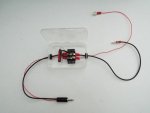KC1LML
Member
Up until now I've used the old tube radios I collect and restore for DXing. I use a 50' outside wire for my antenna. Static (other than lightning) isn't a problem for tube radios. But I decided I wanted to try one of the new portable radios and ordered a Tecsun PL-880, which should arrive in a couple of days.
I'm aware that the RF front end of solid state radios can be damaged by static. I was able to find schematics for the Tecsun PL-880. I see it has a reversed pair of 1N4148 diodes connected between its telescopic antenna and ground. I suppose that's to protect the front end should someone touch the antenna with a static charge on their body. However, the external antenna jack doesn't have that kind of protection.

I was looking around the web, and it looks like most add-on static drains consist of (4) 1N4148 diodes, a reversed pair consisting of (2) diodes end-to-end. If that is really necessary, it seems like Tecsun would have done it on the built-in antenna. It seems like all that would do is raise the forward voltage drop from .7 to 1.4 volts. I suppose it would also limit the static current by a minuscule amount. But is that really going to make a difference to high voltage static or a spark?

In any case, I'm concerned. Static is definitely a problem at our house. I have to keep a humidifier running in my radio room in the winter.
I'm aware that the RF front end of solid state radios can be damaged by static. I was able to find schematics for the Tecsun PL-880. I see it has a reversed pair of 1N4148 diodes connected between its telescopic antenna and ground. I suppose that's to protect the front end should someone touch the antenna with a static charge on their body. However, the external antenna jack doesn't have that kind of protection.

I was looking around the web, and it looks like most add-on static drains consist of (4) 1N4148 diodes, a reversed pair consisting of (2) diodes end-to-end. If that is really necessary, it seems like Tecsun would have done it on the built-in antenna. It seems like all that would do is raise the forward voltage drop from .7 to 1.4 volts. I suppose it would also limit the static current by a minuscule amount. But is that really going to make a difference to high voltage static or a spark?

In any case, I'm concerned. Static is definitely a problem at our house. I have to keep a humidifier running in my radio room in the winter.




